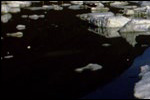|
Anna Massie - Mission 2007 Perspectives Views of Corporations |

| Home
Mission 2007 Team Research Sources Progress Journal |
11/1/03 This week I looked more into the books that I got from the libary as well as look at documents that I found on the web. The books are giving a very general feel on the different issues with oil companies that are out there. I will summarize what I have found from these books later when I have read more into them. I can summarize what I have found on the web, because those documents take a significantly less amount of time to go through.
Arctic Slope Regional Corporation “ASRC will continue to advocate for development of our resources in the coastal plain of the Arctic National Wildlife Refuge (ANWR), but ANWR is not the only egg in the basket. With opposition in Congress still a barrier to ANWR, oil industry attention is now focusing on the National Petroleum Reserve – Alaska (NPR-A). The Company strongly supports exploration and development in the NPR-A because of the jobs and other economic boost it would give to our region.” pg. 4 ASRC and Kaktovik Inupiat Corporation (KIC) own 92,000 acres in the Coastal Plain of the Arctic National Wildlife Refuge (ANWR). I went to this page and would like the two people who gave
us a speech on how to write surveys to look at it and say if
it is biased to give a certain answer. I just have to find their
e-mail addresses again and ask them. Or ask the group if they
have survey experience. My main contact with this company in my opinion will be Oiliver Leavitt who is in charge of Government Affairs, or Karen Burnell who is the Human Resources person. I just am not sure exactly what I would ask them at this current time.
Repulican leaders abandoned the October 3 deadline for the final broad energy bill because of Democratic descent and struggles within their own party. It has been pushed until the third week of October. Senate Democrats will likely filibuster legislation that has to do with ANWR. Republicans have not allowed Democrats to be involved in the discussions around this legislation, which will more than likely prevent a bill from being passed this year. There is an issue with funding as well. They would need a “floor tax credit” to be in place in order for anything to happen.
ASRC was formed in 1997 and is a branch off of the Arctic Slope Regional Corporation. They have 15 major contracts and a base of 700 personnel. They receive $1 billion from the ASRC that they use to work with other contracts. It is classified as an 8(a), Alaska Native Corporation (ANC), Small Disadvantaged Business (SDB). This lets the Federal Government to give ASRC sole-source contacts. 10/19/03 I went to the library fianlly and found about six books that pertain to how the government deals with oil companies both in foreign and local affairs. I will continue to look at them more this week, and next week, but I know that my researching is supposed to come to a close at some point in the near future as well. 10/12/03 "The oil and natural gas industry....is continually looking for ways to further protcet and improve the human and natural environment, while producing the life-saving products that we all need in our daily lives." (p. 3) This I feel sums up the entire purpose of this pamphlet. The coorporations are working together and with the government to make sure that the environment stays as clean as possible. They spent "$7.8 billon " in 2000 in "environmental investments" (p. 3) This went towards exploration, production, transportation, and refining tecuniques all concentrating on making everything more environmentally safe. Because of these and other efforts, "polution levels are decreasing" even as consumption and need grows (p. 3). The Clean Air Act in 1970 has caused refineries and gas emissions to have to decrease, and the improvements made by the oil and gas industries has made this possible. The U.S. Environmental Protection Agency has made many statistics that will be good to look at from the source. The amount of catasrtophic environmental incidents (namely oil spills) have also gone down. Spills are much smaller than they used to be and the large spills are less frequent (p. 5) Also the techniques for cleaning up the spilt oil has improved so more waste can be removed. Waste from oil exploration and drilling has been reduced due to advances such as "3D seismic imaging techniques and directional drilling." (p. 6). Drilling is also able to be unnoticable. For example in Long Beach, California a massive drilling opporation where the companies made islands to place every step of the oporation. According to the pamphlet, "operation takes place so unobtrusively that longtime residents forget it's there." (p. 7). Innovations such as said above have allowed specific oil pools to be specifically pinpointed, and extracted without as large of a "footprint" to be left on the land (p. 8). For example Prudhoe Bay, Alaska has a 5,000 acre area taken over by production, and if it were rebuilt today the area would be reduced by 60 percent (p 8). There are also people looking out for the environment who inspect miles upon miles of pipelines that are all around the nation, checking for potential leaks and hazards using a sensoring system called "smart pigs"(p 9). The refineries are also reducing wastes and emissions. In 2000 they were only "responsible for less than 1 percent of the regulated chemicals emitted by US industries " and are now "recycling more than 60 percent of the wastes they created." (p 10-11).
9/26/03 10/1/03 In our group meeting we discussed exactly what we needed to find out for the assignment. We looked at our specific agenda as written on the Mission page, and those of the groups around us. We decided that we may be covering more information than is absolutely necessary, because it is being covered by another group already. We decided that we do not need to look at the entire United State's point of view on the subject, but need to focus more on the Alaskan people and their perspectives. I will now be researching corporations based in Alaska, or directly related to the oil coming from ANWR. I will still look at the major oil companies of America, including the American Petroleum Institute. I have continued to research more sites for information, but have not really done anything with the information I found. I found the Alaska Department of Natural Resources web site, and it is jam packed with information. I am particulary looking at "2002 Annual Report", and the "Final Finding and Determination for a Solicitation for Offers to Purchase Alaska North Slope Royalty Gas." They look like they cover the subjects of how much oil has been in each area of the North slope, and all of the legistics involved with drilling there. It is a lot of legal mumbo jumbo that I believe will be extremely helpful. It will tell me how the government is interacting with the oil drilling companies and the total benefits and costs from the government, and coorporation standpoint. I will need to speak more to the groups in dealing with the government and the coorporations, including group 2-3 who is looking at how to drill for oil to make sure that I am not overlapping anything that they are also currently researching.
|



| Last updated: Nov. 17, 2003 | Anna Massie
- amassie@mit.edu Team 10 - m2007-10@mit.edu |